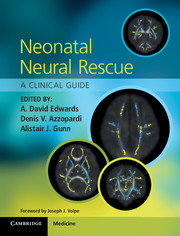Book contents
- Frontmatter
- Contents
- List of contributors
- Foreword
- Section 1 Scientific background
- Section 2 Clinical neural rescue
- 6 Challenges for parents and clinicians discussing neuroprotective treatments
- 7 The pharmacology of hypothermia
- 8 Selection of infants for hypothermic neural rescue
- 9 Hypothermia during patient transport
- 10 Whole body cooling for therapeutic hypothermia
- 11 Selective head cooling
- 12 Hypothermic neural rescue for neonatal encephalopathy in mid- and low-resource settings
- 13 Cerebral function monitoring and EEG
- 14 Magnetic resonance imaging in hypoxic–ischaemic encephalopathy and the effects of hypothermia
- 15 Novel uses of hypothermia
- 16 Neurological follow-up of infants treated with hypothermia
- 17 Registry surveillance after neuroprotective treatment
- Section 3 The future
- Index
- References
15 - Novel uses of hypothermia
from Section 2 - Clinical neural rescue
Published online by Cambridge University Press: 05 March 2013
- Frontmatter
- Contents
- List of contributors
- Foreword
- Section 1 Scientific background
- Section 2 Clinical neural rescue
- 6 Challenges for parents and clinicians discussing neuroprotective treatments
- 7 The pharmacology of hypothermia
- 8 Selection of infants for hypothermic neural rescue
- 9 Hypothermia during patient transport
- 10 Whole body cooling for therapeutic hypothermia
- 11 Selective head cooling
- 12 Hypothermic neural rescue for neonatal encephalopathy in mid- and low-resource settings
- 13 Cerebral function monitoring and EEG
- 14 Magnetic resonance imaging in hypoxic–ischaemic encephalopathy and the effects of hypothermia
- 15 Novel uses of hypothermia
- 16 Neurological follow-up of infants treated with hypothermia
- 17 Registry surveillance after neuroprotective treatment
- Section 3 The future
- Index
- References
Summary
Introduction
This chapter will review novel uses of hypothermic neural rescue. To understand novel uses of hypothermia in neonates, it is helpful to examine novel uses of hypothermia in adult and paediatric patients as applications in one patient group often lead to use in other groups. In most applications of hypothermia neural rescue, there is evidence of benefit in pre-clinical models. This chapter will cover “novel uses” defined as new or promising applications of hypothermia that do not have safety and efficacy in the clinical setting established as yet.
Hypothermia in focal cerebral ischaemia in adults
Adults who suffer acute focal ischaemia currently are managed in the Neuro Intensive Care Stroke Units with supportive management and therapy aimed at recanalization of occluded cerebral vessels with thrombolytic therapy administered within a short therapeutic window. In the preclinical model of acute transient cerebral ischaemia, hypothermia may be protective, if applied early. Reduction in infarct size is noted after middle cerebral artery occlusion with cooling to 30–33°C for 60–180 minutes [1]. In models of permanent focal ischaemia, neuroprotection with hypothermia has not been clearly demonstrated, especially if delayed in onset. The optimum depth of hypothermia in the rat model of focal cerebral ischaemia was 34°C versus 32°C or > 34°C for evaluation of infarct size and 34°C versus all other temperatures for functional outcome, thus indicating a possible U-shaped curve for effectiveness [2]. Rewarming following post-ischaemic treatment with hypothermia at 33°C has been examined in the rat model of focal ischaemia by comparing rapid (within 20 minutes) versus slow rewarming. Infarct size was smaller following slow rewarming compared to normothermia or fast rewarming [3].
- Type
- Chapter
- Information
- Neonatal Neural RescueA Clinical Guide, pp. 166 - 171Publisher: Cambridge University PressPrint publication year: 2013



